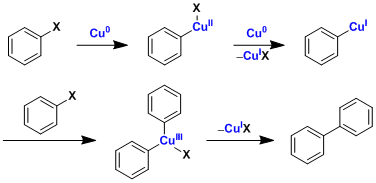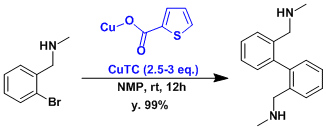- Generality
- Reagent Availability
- Experimental User Friendliness
- Criteria #4
- Criteria #5
-
General Characteristics
The Ullmann coupling is the reductive coupling of aryl halides mediated by copper reagents. This reaction is used for homocoupling purposes except for certain substrate combinations.
The order of reactivity for aryl halides is I>Br>Cl, and the arenes containing electron-withdrawing groups generally react faster.
Nickel(0)-mediated (or catalyzed) conditions are known too.
-
General References
・ Ullmann, F.; Bielecki, J. Chem. Ber. 1901, 34, 2174. doi:10.1002/cber.190103402141
・ Ullmann, F. Ann. 1904, 332, 38.
・ Fanta, P. E. Chem. Rev. 1946, 38, 139. DOI: 10.1021/cr60119a004
・ Fanta, P. E. Synthesis 1974, 9. doi:10.1055/s-1974-23219
・ Hassan,J.; Sevignon, M.; Gozzi,C.; Schulz, E.: Lemaire, M. Chem. Rev. 2002, 102, 1359. DOI: 10.1021/cr000664r
・ Nelson, T.D.; Crouch, R. D. Org. React. 2004, 63, 265.
-
Reaction Mechanism
Though not fully understood, the single electron transfer and the Cu(III)-mediated mechanisms are considered to be likely. The Cu(III) mechanism is shown below.

-
Examples
Copper(I) thiophene-2-carboxylate (“CuTC”) mediates the coupling efficiently at room temperature. The high functional group tolerance is noteworthy. This reagent is commercially available.[1]

An example of diastereoselective Ullmann coupling.[2]

The nickel-promoted Ullmann coupling can be carried out under milder conditions.[3]

Ni(0) is generally very unstable towards air and its handling requires rigorously air-free conditions. The use of zinc as a coreductant helps simplify the procedure.[4] Reducing the nickel loading to substoichiometric amount is possible depending on the reactant type.[5]

-
Experimental Procedure
-
Experimental Tips
-
References
[1] Zhang, S.; Zhang, D.; Liebeskind, L. S. J. Org. Chem. 1997, 62, 2312. DOI: 10.1021/jo9700078
[2] Nelson, T. D.; Meyers, A. I. Tetrahedron Lett. 1994, 35, 3259. doi:10.1016/S0040-4039(00)76879-1
[3] Reisch, H. A.; Enkelmann, V.; Scherf, U. J. Org. Chem. 1999, 64, 655. DOI: 10.1021/jo9817523
[4] Kende, A. S.; Liebeskind, L. S.; Braitsch, D. M. Tetrahedron Lett. 1975, 16, 3375. doi:10.1016/S0040-4039(00)91402-3
[5] Iyoda, M.; Otsuka, H.; Sato, K.; Nisato, N.; Oda, M. Bull. Chem. Soc. Jpn. 1990, 63, 80. doi:10.1246/bcsj.63.80
-
Related Books

